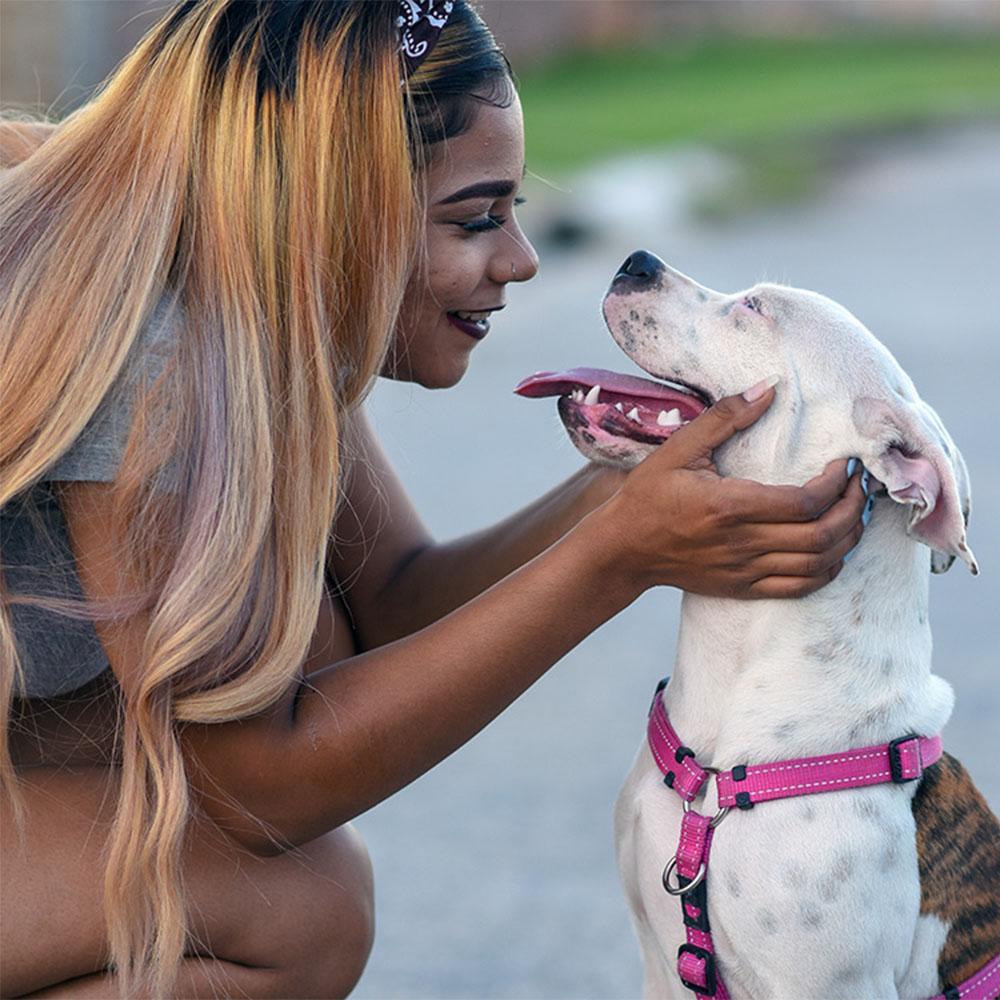Are Pit Bulls Dangerous? Stereotypes About Pit Bull-Type Dogs
Are Pit Bulls dangerous? Uncover the truth behind stereotypes and myths surrounding these misunderstood dogs
Are Pit Bulls dangerous? Uncover the truth behind stereotypes and myths surrounding these misunderstood dogs
by Courtney Elliott, | October 4, 2023

Rushay / Shutterstock
Despite their wiggly tails, cuddly nature, and irresistible puppy eyes, Pit Bulls have been historically labeled as dangerous dogs. But guess what? That stereotype doesn’t hold water. Studies have actually proven that these pups ace temperament tests more often than the average fordog breeds. Pretty impressive, right?
Of course, that’s not to say that things like proper training, socialization, supervision, and all the other bits that go along with responsible pet parenting aren’t vital in ensuring your Pittie is safe to be around other humans and animals. But that goes for all dogs, not just Pit Bulls.
Let’s unpack the history behind this stereotype and learn more about the true nature of these precious pups. If you’re willing to open your eyes and heart, you’ll have the honor of discovering the pure joy that is having a Pittie in your family.
Interestingly enough, a Pit Bull isn’t actually a breed. Generally, five different breeds get bunched into the Pit Bull category. These include:
American Pit Bull Terrier: These fun-loving dogs are all about charm and energy. They usually tip the scales at around 30 to 65 pounds, making them a lively addition to any household. Their love for human affection is matched only by their boundless zest for play.
Staffordshire Bull Terrier (Staffy): These people-pleasing, personality-packed companions weigh in at about 24 to 38 pounds. They love affection from their humans but may prefer to be the only pup in the house.
American Staffordshire Terrier (AmStaff): If you’re into dogs that bring both strength and a heart of gold to the table, AmStaffs are the way to go. Typically weighing between 40 and 70 pounds, they adore being around people and thrive on social interaction.
American Bully: With a sturdy physique and a heart as big as their head, American Bullies are outgoing, happy, and confident. These pups can range from 65 to 85 pounds, and they’re all about the snuggles, making them perfect couch companions.
American Bulldog: American Bulldogs are like the gentle giants of the doggy world. These athletic, warm-hearted pals tip the scales between 60 to 120 pounds. With their stocky build, they’ve got a charming, rugged appearance. Known for their loyalty and protective nature, American Bulldogs make devoted family members.
In addition to these breeds, people tend to use Pit Bull as a catch-all term for mutts who have any of these breeds in their makeup — or any Pit Bull-like features, for that matter. But while they may all be categorized as a “Pit Bull,” they each come with their own unique quirks, personalities, and care requirements.
Pit Bull parents know that these big-hearted bundles of joy are just happy to love on their humans, so why did they get labeled as being dangerous? To understand the stereotype, it’s important to know the history of Pit Bulls.
Pit Bulls were originally bred for bull baiting, a practice where dogs were set to attack and harass bulls and other large animals. When that was eventually outlawed in the mid-1800s, people began to pit their dogs against each other. Large bull-baiting dogs were bred with smaller terriers to create a more agile, athletic breed that would excel in dog fighting. And although dog fighting is illegal, it sadly still occurs today. The aggressive and combative traits that were once encouraged in these dogs for fighting purposes ended up fueling the idea that they’re dangerous.
Another reason Pit Bulls have been stereotyped as dangerous is because of previously published reports about bite statistics by dog breed. Several studies have suggested that the bite rate for Pit Bull breeds is much higher than for other breeds, but several biases in these studies make these conclusions unreliable. For one, there is likely vast overreporting of bites attributed to the breed because any dog with Pit Bull-like features is so often grouped into the same category or because of the dangerous label that’s been unfairly attached to the breed. Two, there may be significant underreporting when it comes to bites from other breeds. And three, people tend to associate Pit Bulls with irresponsible pet parents because of highly-publicized bite cases.
These stereotypes have all led to Breed-Specific Legislation (BSL) that targets Pit Bulls and other so-called “dangerous” breeds, ultimately discriminating against Pit Bull parents and their pups. Unsurprisingly, studies by the Centers for Disease Control (CDC) and the American Veterinary Medical Association (AVMA) document that BSL has had no impact on reducing the number of dog bites among communities, and that animal temperament is mainly influenced by age, sex, training, early socialization, early nutrition, health, and genetics. BSL only takes one of these factors into account and alienates entire breeds of dogs.
In addition to being dangerous, other Pit Bull stereotypes still linger today. For one, some people think that Pit Bulls can’t peacefully coexist with other pets, like cats and smaller dogs. But the truth is that many Pit Bulls, like all dogs, make fantastic companions for animals both big and small when they’ve been properly socialized and introduced. The same goes for training. Pit Bulls have gotten a rap for being difficult to train and having a predisposition for disobedience, but with their eager-to-please nature, Pitties are quite trainable when proper positive reinforcement techniques are used consistently.
Lastly, Pit Bulls are sometimes associated with criminal activity or used as status symbols in illegal activity. This further stigmatizes the breed and unfairly links these dogs to criminal behavior. And it doesn’t help that sensationalized media coverage proliferates these inequitable stereotypes with well-publicized cases of mistreatment and aggression. While any dog can potentially pose a threat when not properly cared for or trained, focusing only on Pit Bull-related incidents perpetuates fear and misunderstanding.
Reducing Pit Bulls to stereotypes doesn’t do justice to the countless loving and gentle Pittie pals who are cherished family members today. Responsible Pit Bull breeders bring out their sweet nature and lessen the aggressive traits, focusing on that friendly, lovable temperament we all admire so much. And there are many sweet natured Pitties in the shelters that just need a loving pet parent to help guide them. With proper training, socialization, and responsible pet parenting, Pit Bulls can be just as affectionate and loyal as any other breed.
While it’s true that Pit Bulls were originally bred for fighting, they are not inherently aggressive dogs. If they’re properly socialized, trained, and cared for, they have the same chance of being aggressive as any other dog. While our Pittie friends have a muscular, sturdy build that people sometimes associate with danger and aggression, they’re actually extremely sweet and loving companions with a good temperament.
In fact, Pit Bulls are sometimes even called “nanny” because of their wonderful temperament around children. And in the results of the largest and defined uniform temperament test performed on dogs, the Pit Bull group was the second highest performing group next to the sporting group. The Centers for Disease Control (CDC) even indicates that primary responsibility for a dog’s behavior should be placed on the pet parent, not on the breed.
Training a Pit Bull breed is similar to training any other dog. The secret sauce? Positive reinforcement. Shower your Pit Bull with praise, treats, and belly rubs when they nail a command - it’s like a high-five for them. And remember, practice makes perfect, so keep the training sessions consistent and frequent and start as young as possible. It’s also never a bad idea to call in the pros. A certified dog trainer or veterinary behaviorist can work wonders when it comes to properly training our canines.
Yes, Pit Bulls can make great family pets. These pups are all about love and loyalty. When they receive the right care, training, and socialization, Pit Bulls can be the perfect playmates for other animals and kids alike. Their big hearts and affectionate nature make them wonderful companions to share your home and your heart with.
If you’re adopting a Pit Bull, you’ll first want to ensure you’ve got the time and resources to commit to training, socializing, regular vet visits, and providing them with top-notch nutrition. If you’re adopting, chat with the rescue to get the lowdown on their history so you have context for any personality traits or potential behavioral issues. At the end of the day, you’re welcoming a new family member into your home, so you want to be set up to give them the love and care they deserve.
Assessment of Canine Temperament in Relation to Breed Groups
Are “Pit Bulls” Different? An Analysis of the Pit Bull Terrier Controversy

Courtney Elliott, a proud Cleveland native living in Manhattan, blends her decade of writing and editing expertise with her unshakable devotion as a pet parent to her French Bulldog, Gus. When she’s not at her desk, you’ll find her frolicking in Central Park or engrossed in a good book at a local coffee shop.